The 4 seasons of viniculture
During opening a bottle of wine, our thoughts often roam wonderful vineyards, the sight of beautiful wooden barrels and, particularly, a very specific relaxation and calmness.
However, to achieve these relaxation and calmness, a lot of laborious work needs to be done until wine is going to be filled up into bottles. It is laborious work and also a lot of manual work. There are a lot of steps in the vineyard, as well as in the wine cellar, that need to be done to achieve an exquisite drop of wine. Overstated, maybe, for a few people this fact can be “recognised by the taste”. However, most of the people remain hidden from the insights into the annual process of a winegrower or from the insights into the origination process of wine.
Insights into our working year – the wine year, visualised by the four seasons of viniculture, illustrated and brought to life by our “wine sheep”:
 The vineyard in winter
The vineyard in winter
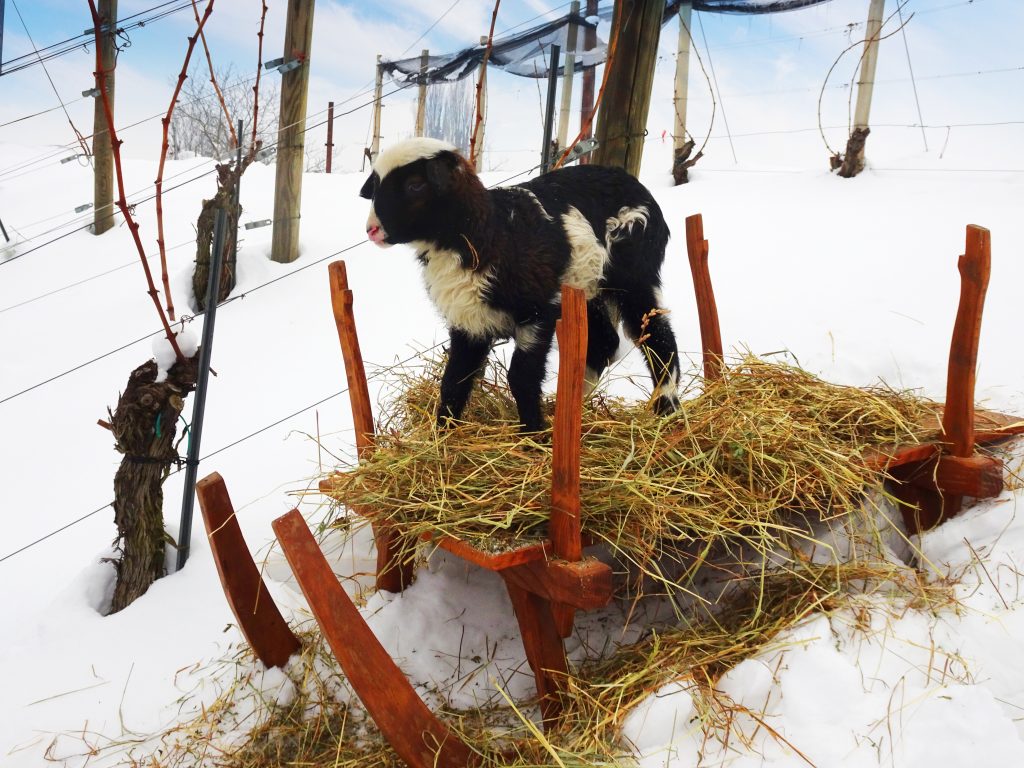
Even in winter, there is a lot of laborious work that needs to be done in the vineyards. In general, a wonderful work. On sunny days you can absorb a lot of solar power and fresh air, outdoors.
During winter season our vines have retreated into hibernation due to the cold temperatures – at that time our vineyard staff handle extensive manual work, usually, for the body difficult climatic conditions. Therefore, in the morning and in the afternoon the cold winter temperatures, as well as the recurring snowfall, are often a very frosty challenge for our vineyard staff.
Pruning – “grapevine pruning”, “(vine) cutting”
During the vegetative rest, which continues until sprouting in spring, the annual pruning of the vines is carried out.
Pruning is considered as a very important task for a winemaker and it is also an essential condition for the successful management and cultivation of a vineyard. Further explained, it is an essential condition for the growth of the vines, for the quality of the grapes, for the handling in the cultivation and for the harvest.
This first regulation of the harvest yield is very important. If too many settings of the grapes remain on the vine, the harvest yield increases, but the quality is going to be reduced, because the basic potential of the vine needs to be distributed among too many grapes. Therefore, the annual pruning is the first most important step in the wine year, regarding quality assurance.
Pruning – “the annual pruning of the one-year old and partly of the tow-year old wood” – this is used to create and to maintain an optimal form of growth of the vines and, consequently, to get an optimal division of the fruit canes (shoots, sprouts). The kind and method of cutting have a very great impact on the plant growth afterwards. The cutting method also depends on the soil condition, on the climate, on further local factors and, above all, on the winegrower’s philosophy. In our winery the pruning is done exclusively by hand. This is very complex and laborious.
Radical cuts on the old wood of the vines cause serious consequences and serious disadvantages. Therefore, we pay greatest attention to a very soft and gentle grapevine pruning, so that the vines remain unhurt.
The method of the soft and gentle pruning bases on old experiences of pruning. This method supports the health and a long lifetime of a vine. This method means to prune only the young wood and to set precised cuts carefully. By precised cutting and by the selection of the fruit canes (sprouts), an attempt is made to keep the vines unhurt, so that the circulation of the plant sap is not interrupted
If possible, no large cuts should be made. There should be made only small cuts and only on the young, one to two years old wood, to minimize the impact on the circulation-system of the plant sap of the vines. (By removing the one to two years old shoots, the young, freshly cut shoots are always left at the base of the previous year’s fruit shoots, so that the new fruit shoots already have connection to the circulation of the plant sap of the vines).
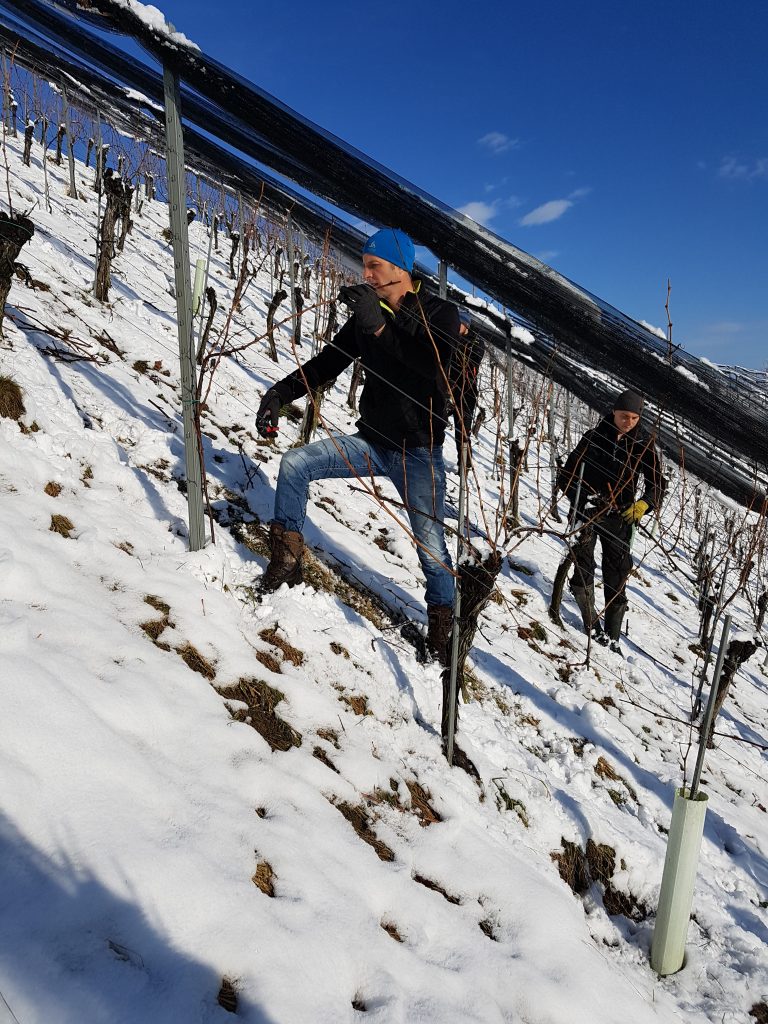
This ensures the prevention of fungal disease, sustainable viticulture based on resistant vines, constant harvest yields and a high wine quality. A normal aging process of the vines is effected by this special method of pruning, as well as by the kind of trim. The vitality of the vines increases, less vines die and this improves the homogeneity of a vineyard.
>>> By the method of a soft and gentle grapevine pruning the plants stay mostly uninjured, the sap flow and the wooden parts are not dehydrated, the risk of fungal disease is going to be reduced.
>>> The method of a soft and gentle grapevine pruning is an important step for an ecological sustainability. Careful pruning insures healthy vines, a good growth and a long lifespan of the vines.
Tying down the fruit canes (rods, shoots)
To get an ideal, loose distribution of the grapes, the fruit rods are going to be tied down.
Hibernation/winter rest
Snow protects the vines against icy winter temperatures. It is a natural protection and keeps the vines in their hibernation.
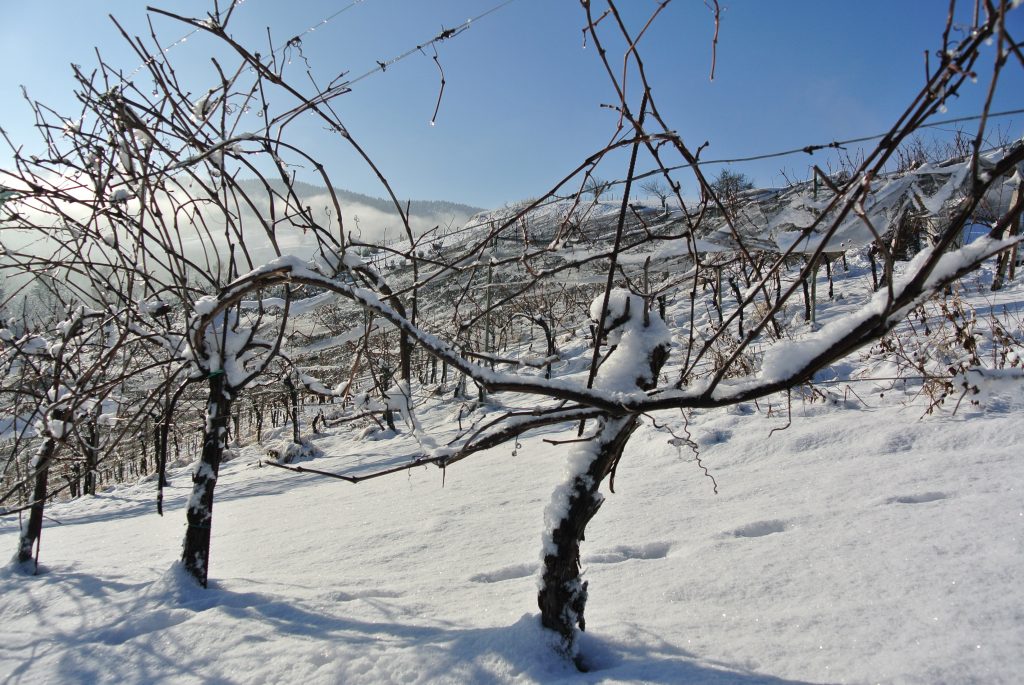
The wine cellar in winter
There is also no winter rest in the wine cellar.
The wooden barrels must be kept full up to the bung hole.
All wooden barrels evaporate a certain percentage of liquid. To compensate this natural loss, the barrels are going to be filled up to the bung hole with an equivalent wine. This technique keeps and ensures the high quality of the wine inside.
“Bung hole” is the naming of the opening on the top of the barrel. It is the highest point of the barrel. If the wine reaches this opening, this is called “full up to the bung hole”. Under this condition, the contact area between the wine and the air above is the smallest possible one in the barrel. Thereby the risk of undesirable oxidation with atmospheric oxygen gets reduced.
Preparation for the bottling
Our Regional Wines are going to be separated from the yeast and bottling is going to be prepared for those wines.
 The vineyard in spring
The vineyard in spring
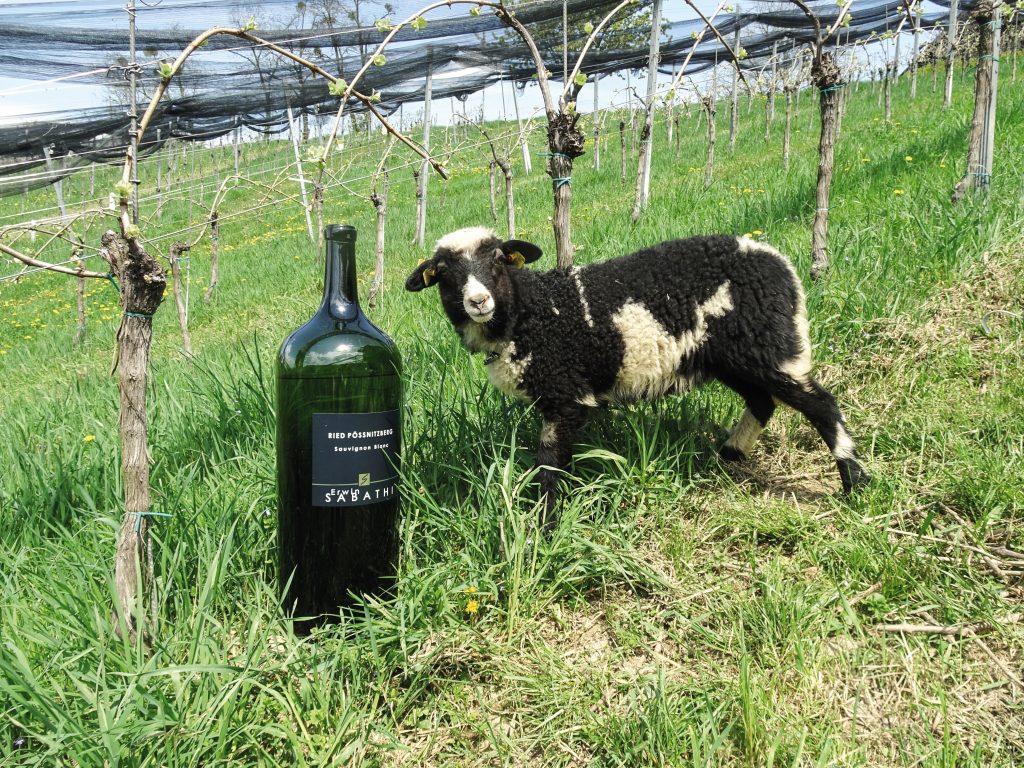
New vines are planted. If replanting is required, old, dead vines will be replaced in existing vineyards. Or, new vineyards are going to be laid out, if needed.
Mowing and mulching, vine care
The vineyards are mowed and mulched for the first time in the new wine year.
During mulching, the grass is cut off and remains in the vineyard to cover the ground. This ecological method serves to protect the soil and to supply the soil with nutrients. The soil in the vineyard is exposed to many external influences such as wind, dryness, etc. Therefore, it is useful to build up a protective layer, the so-called “mulch”. This principle is copied from nature. In the nature, there is practically no naked earth: usually, leaves, broken branches, plants or a humus layer, naturally cover the soil. Correctly mulched, the soil remains damp, the wind cannot dry out the soil and water does not evaporate easily. In turn, rain is absorbed by the earth and does not wash it away. The protective layer also prevents weed growth. Useful natural supporters, such as worms, bacteria and microorganisms, break up the soil under the mulch layer and decompose the organic layer of the grass clippings. By this way, nutrients are added to the soil and the humus layer grows.
Below the vines, the grass is removed mechanically. In the steepest of our vineyards, the grass between the rows of vines and below the vines is mowed by hand and by using a scythe. This is performed under enormous physical effort.
All young vines are hand-weeded (plucked out of grass).
The entire vine care is carried out only on a covered sward, except for young vines.
Cultivation of the vines – plucking the shoots
The most important step regarding quality assurance in spring is plucking the shoots of the vines. All not required, young shoots, shoots that grow from the vines stems and underserved, stunted shoots are removed from the vine by hand. This ensures that only an optimal amount and distribution of young shoots remain on the vine. After pruning in winter, this is the second most important step in quality assurance. In addition to pruning it is a further regulation of the harvest yield – the harvest yield has the greatest impact on the quality of the grapes and therefore, consequently, on the quality of the wine.
After plucking the shoots, the shoots are going to be threaded into the wire framework.
At the end of April, the sprouting of the vines starts. The buds burst, the green shoot tips become visible. During bud break, the vines are extremely sensitive. In spring, late frost can cause serious damages on the young shoots.
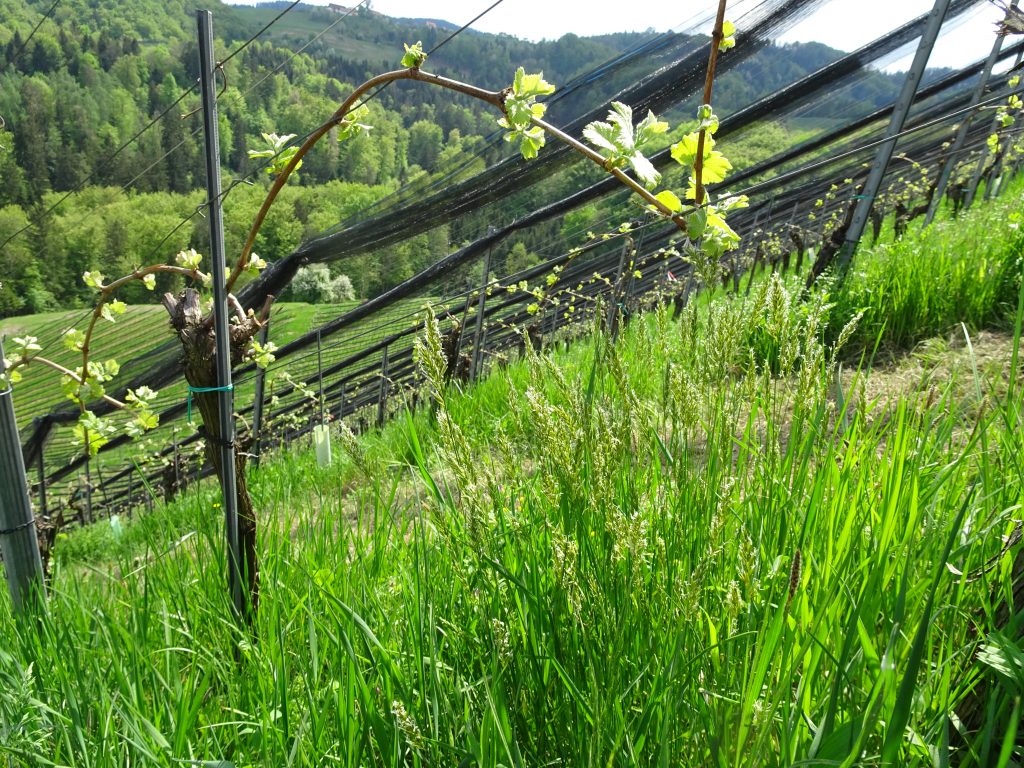
Plant health support
The best plant protection is nature itself. In other words, working in harmony with nature. By creating an optimal habitat for beneficial insects, a natural defence against vermin is built up and the resistance of the vines increases.
To support the flowering of the vines, we usually start plant protection in May. In our winery, only organic-biological plant protection is used. This means that we do not use any synthetically produced fungicides, we do not use any insecticides or herbicides. In addition, we protect our vines mechanically and physically by the use of hail nets.
At the end of May the flowering of the vines starts, this signifies the season change to summer. At this time, the blossoms spread their delightful scent in the vineyards.
The wine cellar in spring
Also during spring, the wooden barrels must be kept full up to the bung hole.
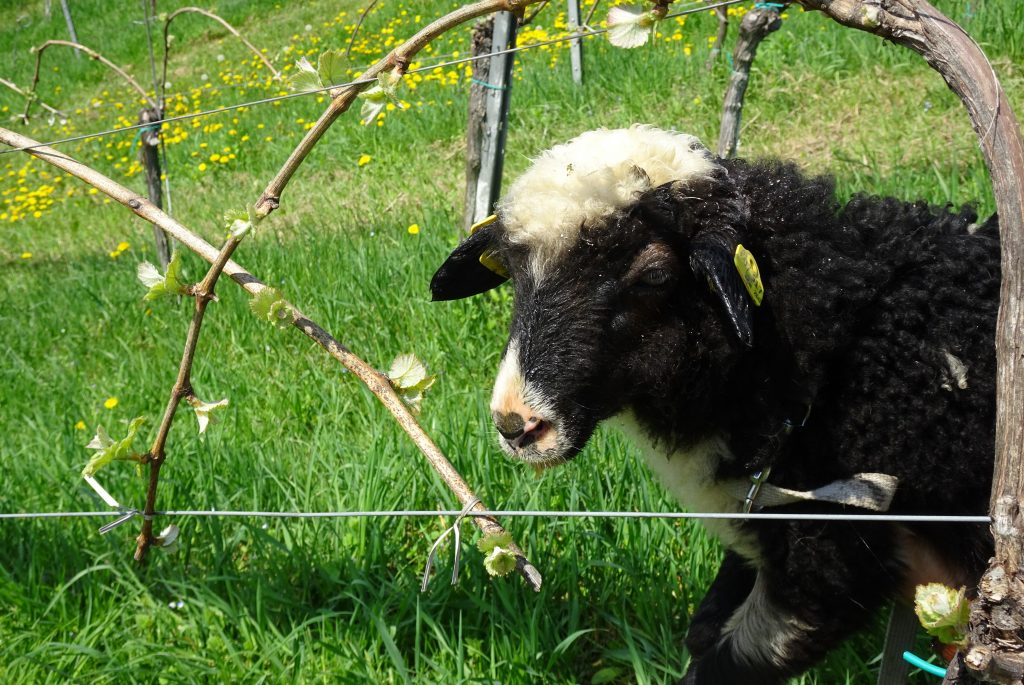
 The vineyard in summer
The vineyard in summer
Still keep on mowing and mulching, vine care
As it was started in spring, mowing and mulching, as well as vine care, are also practiced throughout the whole summer.
During mulching, the grass is cut off and remains in the vineyard to cover the ground. This ecological method serves to protect the soil and to supply the soil with nutrients. The soil in the vineyard is exposed to many external influences such as wind, dryness, etc. Therefore, it is useful to build up a protective layer, the so-called “mulch”. This principle is copied from nature. In the nature, there is practically no naked earth: usually, leaves, broken branches, plants or a humus layer naturally cover the soil. Correctly mulched, the soil remains damp, the wind cannot dry out the soil and water does not evaporate easily. In turn, rain is absorbed by the earth and does not wash it away. Useful natural supporters, such as worms, bacteria and microorganisms break up the soil under the mulch layer and decompose the organic layer of the grass clippings. By this way, nutrients are added to the soil and the humus layer grows.
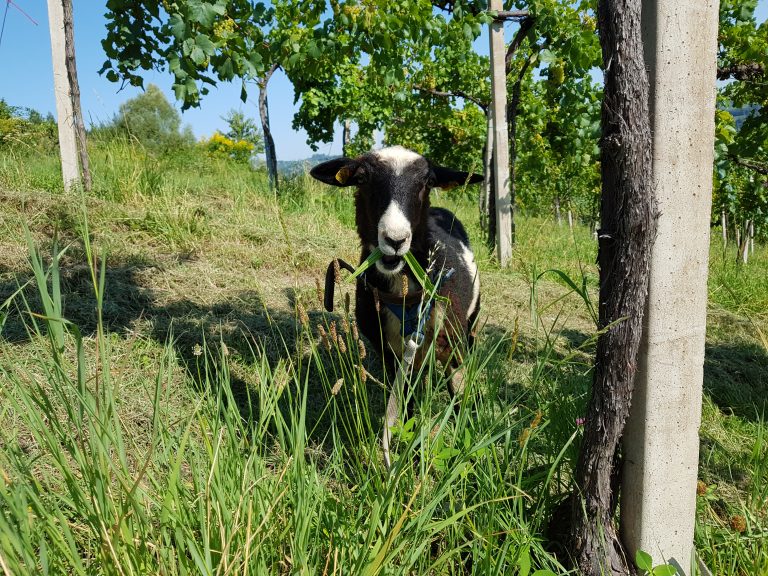
Below the vines, the grass is removed mechanically. In the steepest of our vineyards, the grass between the rows of vines and below the vines is going to be mowed by hand and by using a scythe. This is performed under an enormous physical effort.
All young vines are hand-weeded (plucked out of grass).
The entire vine care is carried out only on a covered sward, except for young vines.
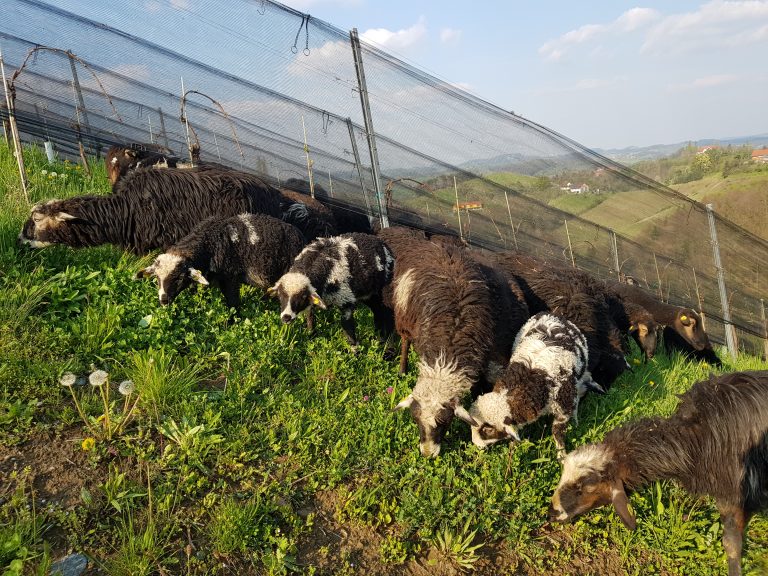
Mowing and mulching by sheep . . .
. . . from milk sheep to “WINEsheep”
Additionally mowing and mulching are supported by sheep of the breed “Krainer Steinschaf”. Marcello and many other sheep are busy mowing and mulching our steep slopes. Therefore, mowing and mulching are done in the most natural way. Since we cultivate all our vineyards organically, there are numerous tender grasses and only the best herbs for the sheep available.
The sheep of the breed “Krainer Steinschaf”, which is an old farm animal breed, are traditional dairy (milk) sheep.
The official race description reads: The “Krainer Steinschaf “ is one of the oldest remaining Austrian sheep breeds, originally based in the Julian Alps in the border triangle of Carinthia, Slovenia and Friuli.”
The small- to medium-framed animals are slender, with a straight nose profile, with short, horizontal, non-hanging ears. The colours are black-brown, white, rarely greying or spotted. The animals are mostly hornless. Forehead, belly and tail are with wool, face and legs are without wool.
The sheep of the breed “Krainer Steinschafe” are resistant and frugal with a good life performance. The hard claws and the coarse mixed-wool with crests on the back causing that precipitation drains well, make them weather-resistant, uncomplicated sheep, which are ideally qualified for grazing.
Through centuries of use as dairy sheep, these animals are very trusting. The herd cohesion is very strong.
Leaf thinning/(foliage treatment/leaf-cut)
During the vegetation period, leaf thinning completes the wintry grapevine pruning. Such as pruning, also leaf thinning is used to create and to maintain an optimal form of the growth of the vines to use the photosynthesis of the foliage at best.
The shoots and the side shoots of the foliage are removed. In our winery, the shortening of the shoots and the removing of the side shoots are carried out at the latest possible time. The later the shoots are shortened, the earlier the physiological maturity occurs > this results in a high quality of grapes.

During summer, the grapes are growing.
Grapes are the infructescence of the vines. The single fruits of the infructescence are called “berries”. Colloquial, the definition “berry” or “grape” is not always used correctly. From the botanic point of view, the shape of the infructescence with branched lateral axes is not a “grape”, it is called “panicle”. The single blossoms of the vines are taken together in an inflorescence, in German called “Geschein”. The peel and the seeds of the berries contain oligomeric proanthocyanidins (OPC). Among other things, they act as powerful antioxidants. There can be made grape seed oil and grape seed flour from the seeds. The seeds, as well as the peel of the berries, are also an essential source of the antioxidant resveratrol.
We are keeping permanently a keen eye on the growing process. This means, in summer our main focus is based on the development of the vines and of the grapes.
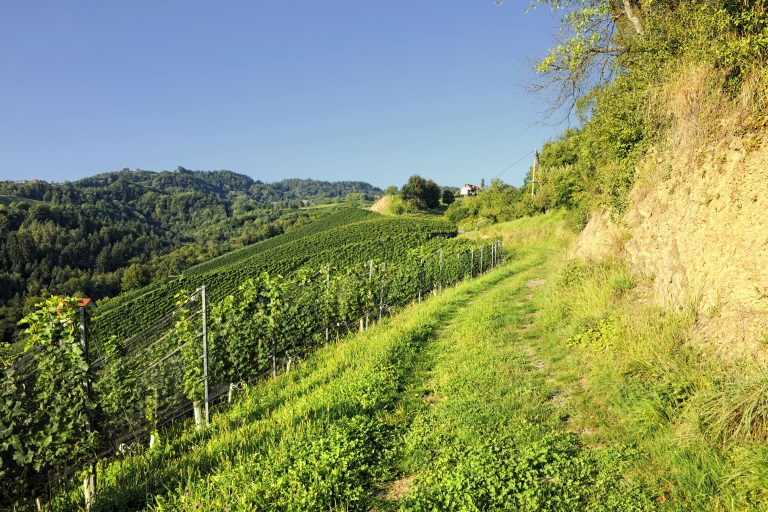
Our vineyards are places full of living nature – our wines are products of grapes from organic and ecological cultivation.
Organic biologic viniculture is also known as “organic viticulture” or “organic wine growing”.
The most important criteria of organic agriculture are:
– the prohibition of the usage of herbicides,
– the support of soil health and soil fertility by a very careful soil cultivation, as well as
– a vineyard cultivation considering the natural circulation
Organic biologic agriculture is an essential measure to increase the biodiversity of the ecosystem in the vineyards. This requires an increased expenditure of time and costs for the soil care and for the natural plant protection.
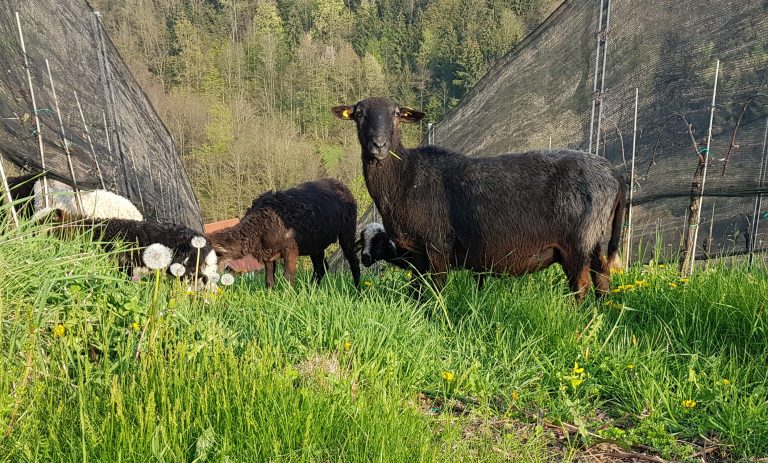

The wine cellar in summer
In the late summer, just before harvesting, our Premier Cru STK Wines are extracted from the oak casks and prepared for the bottling.
During summer the wooden barrels must be kept full up to the bung hole, further on.
 The vineyard in autumn
The vineyard in autumn
Harvesting – the point of time to start picking the grapes is
the important moment
In addition to the conditions of origin and soil, climatic factors and the management philosophy in the vineyards and in the wine cellar the optimal point of time of the harvest is very important for the quality of a wine. The grape harvest is the interface between vineyard and wine cellar.
We keep the grape maturity always in our view
Already during summer we constantly check the condition of our grapes regarding development and maturity level.
Then, a very important aspect of the grape harvest is the correct timing to start picking the grapes . . .
The ripeness of the grapes and the weather conditions determine the start of the grape harvest
The ripeness of the grapes:
The harvest of our grapes is the highlight in the wine year, at the same time the most critical time. By deciding the point of time of starting the harvest, a winemaker can influence the quality and the type of a wine. Depending on how early or how late the grapes are harvested, this effect the sweetness, the alcohol content and the taste of a wine. As the sugar content increases in the berries, the acidity continuously decreases. A perfect balance between acidity and sugar content is a very important factor in the longevity of a wine.
How can the ripeness of the grapes be determined? Winemakers use their sense of taste to decide the exact harvest time. In addition to the winemaker´s sense of taste, which requires years of experience, there are also technical facilities, as the refractometer.
Using a refractometer, conclusions can be drawn on the maturity stage and further on the optimal point of time to start harvesting can be determined.
The weather conditions:
The optimal ripeness of the grapes determines the beginning of the harvest, but also the influence of the weather has an important impact on the starting point for harvesting. Therefore, the question of the correct point of time starting to harvest always is a challenge for us.
Pure varietal harvest, soft handling almost like touching with velvet gloves
The grapes are harvested unmixed, grape variety by grape variety. For further processing they are brought to our press house as soon as possible. We pay greatest attention to fully ripened and healthy grapes as well as to the handling of the grapes, to avoid any damages.
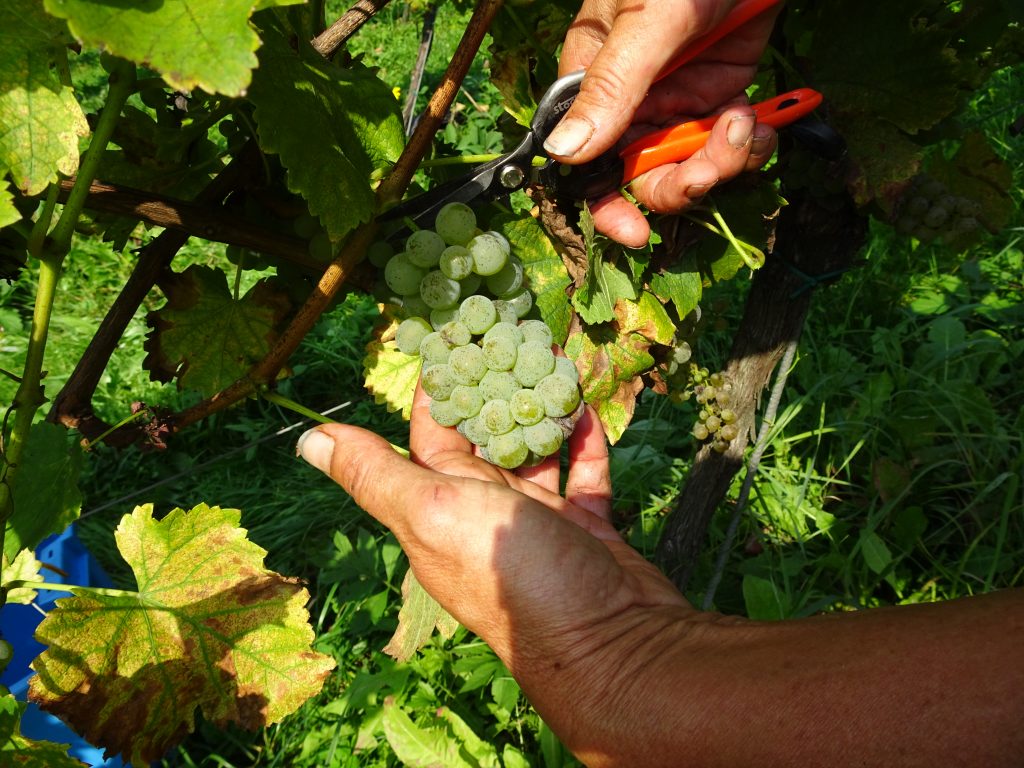
By hand, grape for grape – highest wine quality by the way of the harvest
By the kind of manual harvesting (the traditional way), the ripe grapes are cut by hand, placed in small boxes and by this way the grapes remain completely undamaged.
The advantage of manual harvesting is that only ripe, healthy grapes are actually harvested and a qualitative selection is possible. Berries/grapes that do not fulfill our quality standards are eliminated during the harvest in the vineyard.
Only by the method of harvesting by hand it is possible to select qualified grapes already in the vineyard. Our grape pickers pay highest attention to the degree of ripeness, to the health condition and to the vitality of the berries. Only excellent and ripe grapes are harvested.
We do not use harvesting machines, therefore there are no damages on the foliage, no damages on the grapes and no damages on the soil. Furthermore, there is no impact of mechanical pressure on the grapes and so they get completely undamaged to the wine cellar.
Triathlon in the Vineyard Rows – active muscle power for quality
Due to the very high inclination the picking of the grapes in our extremely steep vineyards is a physically demanding activity, this should not be underestimated. The steepness of our vineyards (sometimes up to 75% inclination) makes harvesting difficult, at this point we say “thank you” to all our grape pickers!

The wine cellar in autumn
While in the autumn the harvest is in progress in the vineyards, subsequently, in the wine cellar, the conversion (refinement) from the juice of the grapes to wine takes place.
After the harvested grapes have been transported well to the press house, there is a lot achieved, the weather can no longer affect the quality.
In the press house the berries are “destemmed” (removed from the stem structure) as gently as possible, squeezed and then pressed very gently in the grape press. The juice of the grapes, more precisely the “grape-must”, flows from the press into the barrels.
After the trub has sedimented in the grape-must, the clarified grape-must is going to be racked and filled up into the barrels. This is followed by the fermentation (carried out only with natural yeasts). During the fermentation process, an expansion effect occurs in the fermentation casks. Therefore the barrels must not be full, as a specific rising space is needed.
After the fermentation has been completed, the barrels are going to be filled up. This is one of the most important steps to ensure the quality of the wine.
“Walking through the wine cellar, it is a good feeling to hear the bubbling of the barrels and to feel the variety of aromas in the nose.”

